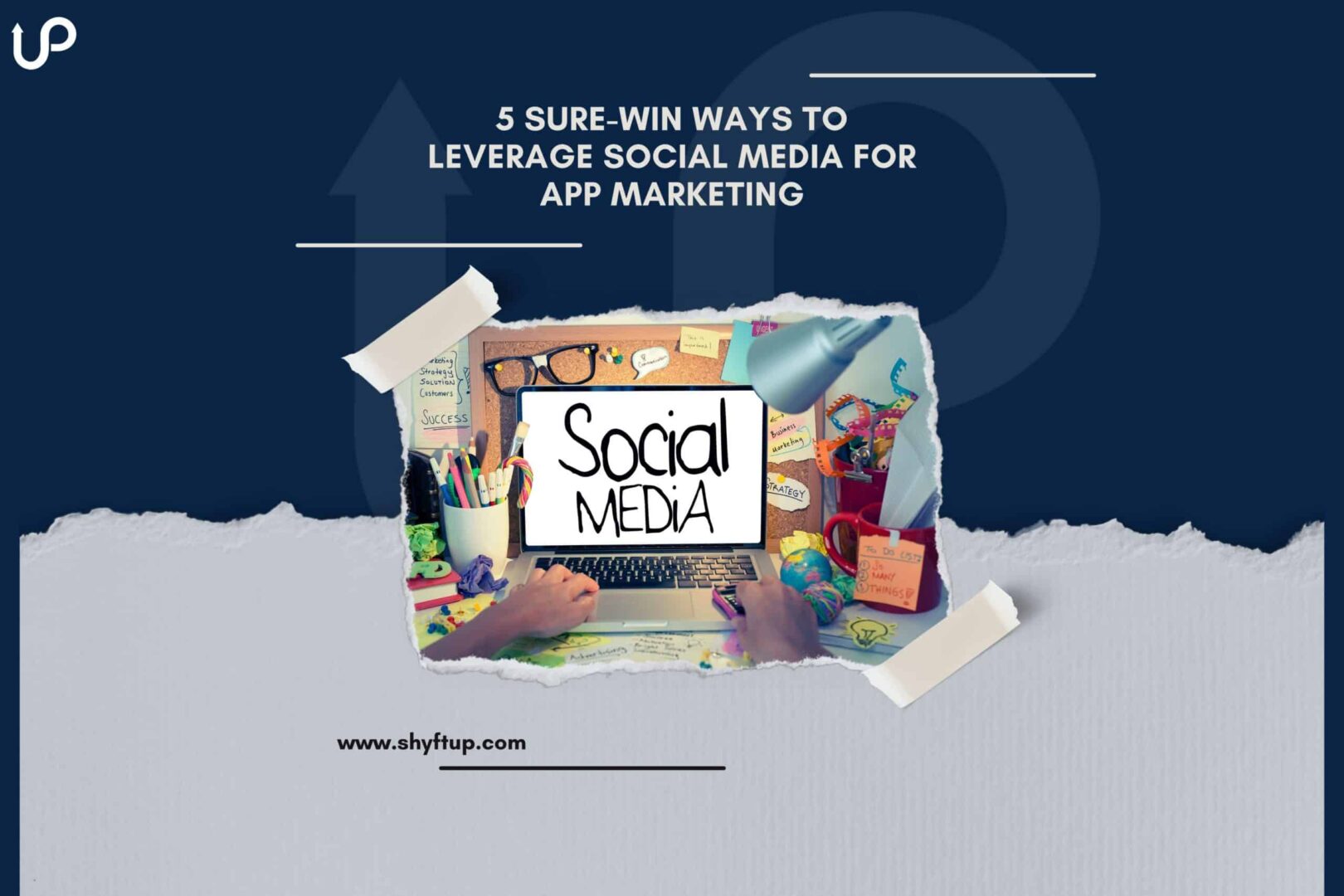
5 Sure-Win Ways to Leverage Social Media for App Marketing
Introduction
Social media is a juggernaut thrown into our lifestyles, swaying our everyday decisions in ways we never dreamed of a few years back. For example, consider the following mind-blowing stats:
- Close to 58% of the world population is on social media (4.62 billion people), spending an average of 2.5 hours daily on them.
- That number jumps to 82% of the population if you look only at the US.
- The frontrunners are:
- Facebook (well over 2 billion people)
- YouTube (nearly 2 billion)
- WhatsApp (1.6 billion)
- Instagram and WeChat (a billion each)
- Tumblr (600,000)
- Tik Tok (500,000)
- Consumers defer to their friends’ social posts 81% of the time before making a purchasing decision.
- Social media referrals connect to 71% of consumer purchases.
- Companies’ social media influences consumer purchases in 78% of cases.
Reliable sources tell us that the app world is no exception and that downloads fall heavily under similar social media influences. So, it gives us a clear track to gain market share and get noticed amongst the over five million others on Google Play and the App Store. The competitive intensity whittles down significantly thanks to market segmentation and people searching by category.
Still, it’s safe to assume you compete with thousands of apps, and it’s crucial to get every bit of market traction that’s there for the taking. Indeed, a research study four years ago signaled that social media ads generated nearly 50% of mobile app downloads. The same metric in 2022 is conceivably way north of that number. Therefore, one’s social media presence on the following five levels vitally contributes to download and conversion success that ultimately bolsters sales revenue:
- Paid ad campaigns
- Leveraging influencer marketing
- Recognizing and rewarding users who create content around your app
- Focusing on your app reviews and ratings
- Maximizing different social media platform advantages
A. A paid ad campaign
Social media advertising investment in North America topped around $47.9 billion in 2021 – close to one-fifth of the total, including TV, radio, press, outdoor media, and publications. Indeed, social media is a massive player in the $240 million promotions industry. One of paid advertising’s significant drivers is the fading reliance on organic reach strategies. The latter requires endless patience and frustration tolerance as algorithms swing our efforts left and right, sometimes with disappointing results. Nevertheless, there’s no getting away from social media as a mainstay promotional channel for every app business interested in building brand loyalty.
The compelling attractions of paid advertising are:
- Speed in penetrating markets, unmatched by organic programs.
- The high degree of sustainability validated by tangible results.
- Relying on the undoubted message frequency benefits that are under your control.
Marketers will notice that all the social media leaders accommodate app installs as an advertising option, so take advantage of that. Moreover, don’t hesitate to draw on the expertise of the Facebook team to zone in on the audience most responsive to your messages. A hit-and-miss, shotgun approach gives way to sniper accuracy, easily attainable with the pay-per-click system (relatively inexpensive) that takes you to genuine customers. So, in other words, generalization gives way to a granular approach, thus escalating downloads while simultaneously saving on the advertising budget – a double-whammy benefit.
B. Leveraging influencer marketing
A social media influencer is a person who has established industry recognition as an opinion leader, thus shaping the acts of consumers choosing brands available in that industry’s markets. It implies that influencers enjoy significant credibility with a substantial audience that relies on their recommendations.
There’s no denying the impact of influencer marketing. The funding sunk into this promotional vertical galloped from $1.7 billion in 2016 to the expected $16.4 billion in 2022. Short videos on TikTok, Facebook, and YouTube (to mention a few) are the primary trend catalysts. Combined with the global pandemic, the latter pushed consumers to align more emphatically with people they admire. In other words, the influencer trend is on a tear, endorsed by a Twitter report that puts influencer impact on purchases as high as 40%.
So, connecting social media marketing for apps to your brand with influencers will likely thrust it into the midst of an engaged and receptive audience. We advise that Instagram leads the influencer parade as a preferred channel, followed by Facebook (despite the latter reflecting more than twice the users.) Moreover, consult with your selected influencers. Why? Because nobody has better insights into consumer emotions, thinking, and behavior than this pivotal category. They’ll give you specific hand-holds to climb onto the revenue bandwagon and stay there.
C. Recognizing and rewarding users who create content around your app
Social media marketing for apps aligns closely with reading into data. Nielsen – the global iconic market research entity – underlines that peer recommendations figure into 90% of customer actions versus 33% ad influenced. It elevates “User-Generated Content” (UGC) to the front of every app marketer’s attention. It involves pressing your users to submit screenshots, videos, and content that creates interest in the app’s benefits and features.
The emphasis should be on lifestyle improvement and your brand’s role in making that a reality. Create excitement like contests and seasonal events to interact with your customers, providing fertile material for users to get hyped about and spread that excitement to others. When fun’s in the mix, friends and family gravitate toward it like iron shards to a magnet.
D. Focus on your app reviews and ratings
This ties in with the other tactical moves suggested above, complementing those efforts significantly. So, we recommend that promoting your best reviews on social media directly impacts your app downloads. Did you know that 60% of app downloaders rely on ratings and reviews as the #1 indicator of value? You should take notice because companies like Facebook regularly display their user reviews. If it’s good for them, then it’s a no-brainer clue for aggressive marketers to follow that lead. Squeeze the maximum mileage from every positive review by displaying it on YouTube channels like Daily App Show, Product Hunt – a primary review site, and others. Thus, creating boosted visibility that counts.
E. Maximize different social media platform advantages
Appreciating each unique advantage set emerging from a social media selection will inject momentum and energy into your promotional strategies. Consider the following:
1. Facebook for Community Building
Create a Facebook page that engages app users from every possible angle. It involves:
- Regularly introducing new incentives like discounts, special offers, or referral rewards.
- Using every seasonal event as an opportunity to create a theme, thus building brand excitement.
- Throw in different contests, giveaways, and free trials mixed in with hi-def images, engaging videos, GIFs, and interesting articles.
- Join Facebook groups that align with your app, thus allowing you to talk about your brand in a low-key conversational manner. There are a few better ways to initiate installs.
2. Be informative on Quora
Quora is a site people go to for pertinent, no-nonsense viewpoints and opinions. Look for openings to enter conversations around your app’s interest area. When adding content, propose your brand and company as a solution to pain points emerging in Quora interactions.
3. Instagram users love “sneak peaks”
Instagram is the #1 visual platform versus all-comers, welcoming you to post video promos, screenshots – anything that pops! Creating the impression of “first to know ahead of the crowd” generally solicits an extra dose of attention. We suggest deploying up to 30 relevant hashtags and posting twice daily to get the best out of Instagram.
Finding the optimal balance between entertainment value, “how-to” tips, and feature explanations will build better responses. Then, fine-tune things with a good mix of app screenshots, images, shoutouts to influencers, and unique promotions.
Make a brand name central to all the messaging outlined above. Sometimes creative artwork gives your brand the Instagram edge it needs for noticeability. In addition, get familiar with other ways to Instagram openings that can help differentiate your presentation.
4. Twitter zones in on accumulating users
This platform thrives on exchanging ideas through robust interaction. Therefore, share engaging content, update your brand loyalists with breaking news, and prod the latter to leave reviews. In other words, prompt dialogue to sustain app usage and develop user retention. Do this by:
- Either asking users to tweet their feedback individually
- Or share results after a poll distribution
Indeed, extend your Twitter strategy to cover a significant portion of customer service.
Conclusion
Social media promotion is a diverse field that lends itself to every aspect of market segmentation and app user definition. It calls for mapping out customer journeys, touchpoint by touchpoint, then connecting the latter to the social media that work best.
Fill in gaps by talking to ShyftUp – a leading global User Acquisition Agency. They’ll help you decide on your social media promotional strategies for your app portfolio. ShyftUp focuses on two primary services:
- App Store Optimization (ASO) – unleashing the power of organic user growth by creating boosted visibility on the app stores.
- Paid User Acquisition – to help you grow your user base by converting your paid marketing budget into real users, thus revenue. ShyftUp specializes in Apple Search Ads and Google UAC channels.
How can social media be used as a marketing strategy?
To get traction via the following: A paid ad campaign, Leveraging influencer marketing, Recognizing and rewarding users who create content around your app, Focus on your app reviews and ratings, Maximize different social media platform advantages.
Which app is best for social media marketing?
You can’t omit Facebook, but every option has unique benefits. The more granular you get in the analysis, the better.
B. Leveraging influencer marketing
C. Recognizing and rewarding users who create content around your app
D. Focus on your app reviews and ratings
E. Maximize different social media platform advantages
1. Facebook for Community Building
3. Instagram users love “sneak peaks”
